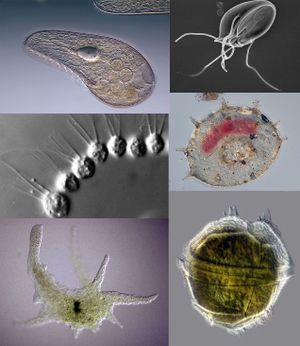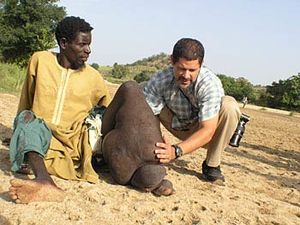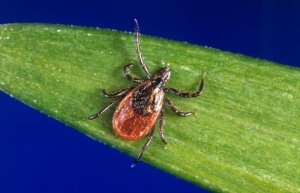Parasitic Infections
Original Editor - Lucinda hampton
Top Contributors - Lucinda hampton, Kim Jackson and Nupur Smit Shah
Introduction[edit | edit source]
A parasite is an organism that lives on or in a host organism and gets its food from or at the expense of its host. There are three main classes of parasites that can cause disease in humans: protozoa, helminths, and ectoparasites.
Infections of humans caused by parasites number in the billions and range from relatively innocuous to fatal.
- The diseases caused by these parasites constitute major human health problems throughout the world.
- The incidence of many parasitic diseases (e.g malaria) have increased rather than decreased in recent years.
- Other parasitic illnesses have increased in importance as a result of the AIDS epidemic (e.g: cryptosporidiosis a diarrhoeal disease caused by the parasite, Cryptosporidium, which infects the intestine;Pneumocystis carinii pneumonia).
- The migration of parasite-infected people, including refugees, from areas with high prevalence rates of parasitic infection also has added to the health problems of certain countries[1].
The life cycle of parasites can be very complicated. During their life, parasitic organisms typically go through several developmental stages that involve changes not only in structure but also in biochemical and antigenic composition. eg. Helminths form three main life-cycle stages: eggs, larvae and adults, helminth larval stages have little resemblance to the adult stages. for example, those of tapeworms and flukes[1].
Image at R: Image R: Collage of Protozoans: Clockwise from top left: Blepharisma japonicum, a ciliate; Giardia muris, a parasitic flagellate; Centropyxis aculeata, a testate (shelled) amoeba; Peridinium willei, a dinoflagellate; Chaos carolinense, a naked amoebozoan; Desmerella moniliformis, a choanoflagellate
Parasitic Infections[edit | edit source]
Parasitic infections cause a tremendous burden of disease in both the tropics and subtropics as well as in more temperate climates.
- Of all parasitic diseases, malaria causes the most deaths globally.
- Malaria kills more than 400,000 people each year, most of them young children in sub-Saharan Africa.
A misconception about parasitic infections is that they occur only in tropical areas. Although most parasitic infections are more prevalent in the tropics, many people in temperate and subtropical areas also become infected, and visitors to tropical countries may return with a parasite infection.[1]
The Neglected Tropical Diseases (NTDs) include parasitic diseases such as:
- Lymphatic filariasis (see image 1.)
- Onchocerciasis (an eye and skin disease, the symptoms are primarily caused by microfilariae. It's common name – river blindness. Onchocercal blindness is the world’s fourth leading cause of preventable blindness after cataract, glaucoma and trachoma[2];
- Guinea worm disease, a painful and debilitating disease – dracunculiasis, commonly known as guinea-worm disease, is on the verge of eradication due to a highly focused international public health initiative that uses inexpensive, practical interventions in target areas. This worm is the largest of the tissue parasite affecting humans. The adult female, which carries about 3 million embryos, can measure 600 to 800 mm in length and 2 mm in diameter.[3]
Parasites are frequently transmitted to humans through contaminated food. The disease burden due to most foodborne parasites is highly focal and results in significant morbidity and mortality among vulnerable populations[4]. These diseases extract a large toll on endemic populations, including lost ability to attend school or work, stunting of growth in children, impairment of cognitive skills and development in young children, and the serious economic burden placed on entire countries[5].
Protozoa[edit | edit source]
Protozoa are microscopic, one-celled organisms that can be free-living or parasitic in nature. They are able to multiply in humans, which contributes to their survival and also permits serious infections to develop from just a single organism. Transmission of protozoa that live in a human’s intestine to another human typically occurs through a fecal-oral route (for example, contaminated food or water or person-to-person contact). Protozoa that live in the blood or tissue of humans are transmitted to other humans by an arthropod vector (for example, through the bite of a mosquito or sand fly)[5].
Protozoa that are infectious to humans can be classified into four groups based on their mode of movement
- Sarcodina: Utilize pseudopodia for movement. Includes amoebas such as Entamoeba (dysenteric liver abscess), Dientamoeba (colitis), and Acanthamoeba[6] (can cause a serious, most often deadly, infection of the brain and spinal cord called Granulomatous Encephalitis).
- Mastigophora: Utilize flagella for movement, and include Giardia (diarrhea), Trypanosoma (sleeping sickness and Chagas disease), Leishmania (visceral, cutaneous and mucocutaneous leishmaniasis), and Trichomoniasis is a sexually transmitted infection (STI) caused by a parasite, spread most often through vaginal, oral, or anal sex[7].
- Apicomplexa: Use an apical complex to move. Includes: Plasmodium (malaria), Toxoplasma ( a zoonotic infection caused by the parasite Toxoplasma gondii with a wide range of clinical syndromes in humans. World Health Organization (WHO) estimates that every year there are over 1 million cases of toxoplasmosis in the European region caused by contaminated food. For women, infection with Toxoplasma during or just before pregnancy can be particularly serious resulting in miscarriage, stillbirth or child disability. Cats are the primary hosts of the parasite, and they can excrete oocysts with their feces in the environment, which then can infect other animals and humans[8]).
- Ciliophora: These move with cilia and include Balanidium, a large ciliated protozoan, the only ciliate known to be capable of infecting humans. (dysentery).About 1 % of the world's population is infected with balantidiasis. Most infections occur in developing countries where feces are more likely to get in contact with food and drinking water. In addition to humans, pigs and other animals carry the disease. People who raise pigs have bigger risk of getting infected with balantidiasis[9].
Helminths[edit | edit source]
Helminths are large, multicellular organisms that are generally visible to the naked eye in their adult stages. Helminths can be either free-living or parasitic in nature. In their adult form, helminths cannot multiply in humans. There are three main groups of helminths (derived from the Greek word for worms) that are human parasites:
- Trematodes: Fasciola Hepatica - Liver Fluke; Fasciolopsis Buski - Intestinal Fluke; Paragonimus Westermani - Lung Fluke; Schistosoma - Blood Flukes
- Cestodes (tapeworms): Diphyllobothrium Latum - Fish Tapeworm; Hymenolepis Nana - Dwarf Tapeworm; Taenia Saginata - Beef Tapeworm; Taenia Solium - Pork Tapeworm
- Nematodes (roundworms) and cause a variety of diseases in humans, which may be intestinal or may attack specific tissues directly. Include: Ascaris Lumbricoides - Giant Roundworm; Enterobius Vermicularis - Pinworm; Hookworms; Loa Loa - Eye Worm - Subcutaneous Filariasis; Strongyloides Stercoralis; Trichuris Trichiura - Whipworm; Wuchereria Bancrofti - Lymphatic Filariasis - Elephantiasis. See image at R.[9].[10]
Ectoparasites[edit | edit source]
These are organisms that live externally on the skin of hosts. Skin parasites drink blood or eat skin. They are usually so small that you cannot see them. Some species are burrowed into the skin whereas many simply crawl on it. Some parasites can complete their whole life cycles in humans. But many live outside the body only feeding every once in a while. Skin parasites can live in the skin as an egg, larva, nymph or adult stage[9]. Eg.
- Cimex Lectularius - Bedbugs feed on human blood during the night. The most common bedbug is Cimex lectularius.
- Dermatobia hominis - Human Botfly
- Sarcoptes Scabiei - Scabies is characterized by itching and rash. It is caused by tiny mites called Sarcoptes scabiei[9].[10].
Treatment[edit | edit source]
Antiparasitic drugs are used to manage infections caused by various protozoa, helminths, and ectoparasites. Treatment options vary, depending on the specific causative organism within each group.
Since 1960 the introduction of new drugs has enabled remarkable advances in the chemotherapy of some endoparasitic infections. Albendazole and mebendazole have significantly improved the treatment of several intestinal nematode infections, whereas praziquantel has revolutionized the treatment of trematode and cestode infections. At the same time, metronidazole and tinidazole have provided more effective and less-toxic drugs for the treatment of amebiasis, giardiasis, and trichomoniasis.
Unlike endoparasitic infections, ectoparasitic infestations are caused by organisms that live on the skin or hair shafts of patients. The most common examples are the lice and mites that cause pediculosis and scabies, respectively. Well known ectoparasiticidesused used to kill the parasites that live on the body surface are: Permethrin, sulfur, lindane, dicophane, benzyl benzoate, ivermectin and crotamiton.[11]
Education re use is paramount to attain better outcomes (the implementation of long term community programs are necessary for endemic regions). In many cases, the antiparasitic drugs have severe adverse reactions, and thus, adherence with medications is low. Therefore, direct observer therapy by the pharmacist may be essential if one wants to improve outcomes[10].
References[edit | edit source]
- ↑ 1.0 1.1 1.2 Smyth JD, Wakelin D. Introduction to animal parasitology. Cambridge university press; 1994 Nov 24.Available from:https://www.ncbi.nlm.nih.gov/books/NBK8262/ (last accessed 12.11.2020)
- ↑ WHO Onchocerciasis Available from:https://www.who.int/apoc/onchocerciasis/disease/en/ (accessed 13.11.2020)
- ↑ WHO Dracunculiasis eradication Available from:https://www.who.int/dracunculiasis/disease/en/ (last accessed 13.11.2020)
- ↑ WHO Parasites Available from:https://pubmed.ncbi.nlm.nih.gov/26633705/ (last accessed 13.11.2020)
- ↑ 5.0 5.1 CDC Parasites Available from:https://www.cdc.gov/parasites/about.html (last accessed 12.11.2020)
- ↑ Medicine Net Acanthamoeba Available from:https://www.medicinenet.com/acanthamoeba/article.htm#what_are_the_symptoms_of_acanthamoeba_infection (last accessed 13.11.2020)
- ↑ Medicine net Trichomoniasishttps://www.medicinenet.com/trichomoniasis/article.htm#how_do_you_get_trichomoniasis (last accessed 13.11.2020)
- ↑ WHO Taxoplasmosis Available from:https://www.euro.who.int/__data/assets/pdf_file/0011/294599/Factsheet-Toxoplasmosis-en.pdf?ua=1 (accessed 13.11.2020)
- ↑ 9.0 9.1 9.2 9.3 Parasites in Humans Available from:http://www.parasitesinhumans.org/balantidium-coli.html (last accessed 13.11.2020)
- ↑ 10.0 10.1 10.2 10.3 Campbell S, Soman-Faulkner K. Antiparasitic Drugs.Available from:https://www.ncbi.nlm.nih.gov/books/NBK544251/ (last accessed 13.11.2020)
- ↑ Basicmedical Key Parasitic drugs Available from:https://basicmedicalkey.com/antiparasitic-drugs/ (last accessed 13.11.2020)











